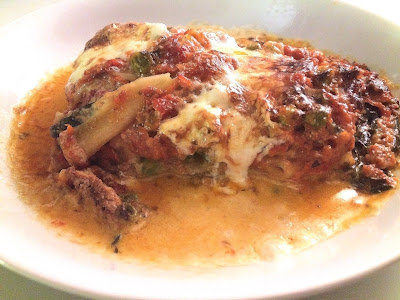YOU MAY THINK I'M JOKING when I say everything under the kitchen sink, but we all know what it's like to have a variety of "things" in the refrigerator which you just, quite simply, cannot throw out! When I get to that point, especially when the weather turns inclement, i.e., bitterly cold, I immediately think of one of the best comfort foods for any Italian with brains: LASAGNA!
 |
| LASAGNA |
If you've made Osso Buco with a red sauce, half the battle is over since all you'll have to do it take the meat and grind it or chop it or better yet, process in a Cuisinart. Put back in the red sauce and heat up to warm and add 1/4 cup of baby peas. Set aside.
You can process the braised fennel as well and add it, along with the green vegetable, to the Bechamel Sauce which is made as follows:
Preheat the oven to 400º.
In a small saucepan, heat 2 cups of whole milk to the simmer. While the milk is heating up, melt 4 tbl. of unsalted butter on medium high heat in a medium-sized saucepan. When the butter has melted, is bubbling and has turned the color of amber add 4 tbl. of flour. Stir this with a wooden spoon and turn the heat down to medium and continue to stir until all the flour has been incorporated into the butter and the mixture takes on a nutty color. Immediately add the heated milk, turn the heat up to high and whisk until the mixture comes to the boiling point. Boil for about 5-6 seconds or until the sauce becomes very thick. Remove from heat, add salt and white pepper, a dash of nutmeg to taste. Add the kale (or spinach), fennel and parmesan. If the sauce is too thick, drizzle in some milk until you have a smooth consistency. Dot top with pieces of butter. At this point you should make an assembly line of ingredients in their respective pots surrounding the lasagna dish.
Ladle some of the Ragù on the bottom and place the first layer of pasta on top of that. Add more Ragù on top of the pasta sheet and place a couple of slices of eggplant on top of that. Place more pasta on top and ladle some of the Bechamel on top of that. Sprinkle some cheese on top (or add pieces of leftover cheese on top; sometimes if I have Taleggio or Fontina, I put that in as well). Continue to make layers as before, using up the eggplant with the Ragù and alternating with the Bechamel until all the sheets are used up. As you get closer to the end, you'll need to gauge the amount of sauce you use so everything is used up (Bechamel does not keep and is horrible reheated). Just make sure you pour all of the Bechamel on top of the last layer of white sauce and all the Ragù on the very top of the lasagna. Drizzle about 1/2 cup of heavy cream all around the sides of the pan. Dot the lasagna with pieces of fresh mozzarella and place a few toothpicks or small metal skewers into the lasagna so you can tent the pan with aluminum foil to avoid melted cheese sticking to the foil. Place the lasagna pan on a large roasting sheet pan lined with lots of aluminum foil.
Bake for 40 minutes and remove the foil from the top. Bake for another 15-20 minutes. The top should be a golden brown and the sauce should be bubbling at the edges. If you see any signs of melted grease accumulating at the edges, you've baked it too long so it's advisable that you keep a close eye on the lasagna after you've removed the foil. Remove the lasagna from the oven and allow to cool for about 15 minutes to settle. It will be much easier to cut if it rests a bit.
Serves at least 8 people as a main course or you can make smaller portions and feed 12-14 as a first course.
 |
| Glorious Lasagna |
Buon appetito!!!
No comments:
Post a Comment